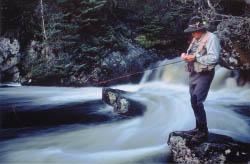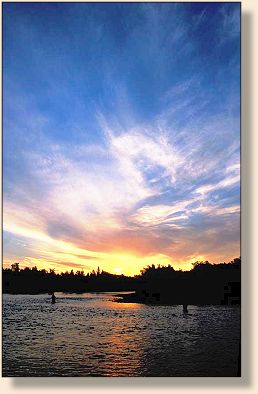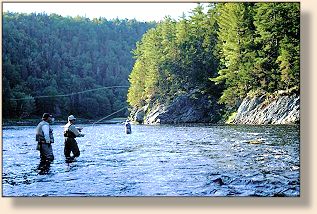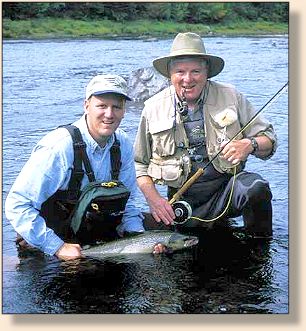September On The Miramichi

By Chris Marshall
Glen Hales photos
 Until I retired a couple of years ago, I'd never had the opportunity to fish for salmon
in the fall. As a teacher, I'd always been obliged to do my salmon fishing in July and
August not exactly the best time. Therefore, when Glen Hales, our Associate
Photo Editor, and I got an invitation to fish the Little Southwest Miramichi this past
September, I was more than ready even though it was a sort of business trip
and I knew I'd spend more time out of the river than in it.
Until I retired a couple of years ago, I'd never had the opportunity to fish for salmon
in the fall. As a teacher, I'd always been obliged to do my salmon fishing in July and
August not exactly the best time. Therefore, when Glen Hales, our Associate
Photo Editor, and I got an invitation to fish the Little Southwest Miramichi this past
September, I was more than ready even though it was a sort of business trip
and I knew I'd spend more time out of the river than in it.
We arrived late Sunday afternoon after a ten-hour drive through the rain from Ontario.
As we turned on to the dirt road into the valley of the Little Southwest just upstream
from Halcomb, the sun came out, kindling the first patches of gold and vermilion on the
trees on the north bank. Rain followed by sun it was an omen. We weren't surprised
to find that anglers at Upper Oxbow Adventures Lodge, where we were guests for
the next few days, had taken three grilse that day.
Next morning, we were on the river just upstream from the lodge soon after sun-up,
although in the fall there's really no need to get up early. By September, with the sun
at mid-day so much closer to the horizon and the water so much cooler, the salmon
are more active and the fishing remains good throughout the day.
 Although I'd fished the main branch of the Southwest a number of times, this was my
first time on the Little Southwest not to mention my first time fishing for salmon in
the fall. Therefore, I was grateful for the expertise of my guides for the day, Luke Dyer
and Jacques Heroux of Salmon Anglers Online. Jacques, a well-known
New Brunswick fly tyer, insisted I use one of his favourite fall patterns, Ally's
Shrimp, and showed me how to attach it to my leader with the Miramichi knot a
knot designed to impart optimum action to the fly on the downstream swing.
Although I'd fished the main branch of the Southwest a number of times, this was my
first time on the Little Southwest not to mention my first time fishing for salmon in
the fall. Therefore, I was grateful for the expertise of my guides for the day, Luke Dyer
and Jacques Heroux of Salmon Anglers Online. Jacques, a well-known
New Brunswick fly tyer, insisted I use one of his favourite fall patterns, Ally's
Shrimp, and showed me how to attach it to my leader with the Miramichi knot a
knot designed to impart optimum action to the fly on the downstream swing.
There was no wind, and tendrils of mist rose slowly from the water. Perfect! Step
by step, we fished through the pool. Just downstream from me, Luke rolled a fish
and magnanimously moved on, leaving it for me. I cast to it half a dozen times,
holding my breath each time the fly swung over the lie, but it mustn't have really
been in the mood. So we fished on down.
Before we broke for lunch, we'd had pulls from three more fish, but no hook-ups.
By this time, the wind had got up and was gusting from the southeast directly on
our right ears, which always presents a problem for right-handed casters. As the
others rolled in, we were entertained with blow-by accounts of a number of fish
missed, lost, and a couple caught. Typical for late September on the Miramichi.

In the fall, spurred by the cooling water, salmon tend to be more aggressive than
they are in the summer. They're more likely to hit a fly and they're less finicky about
pattern and size. Some fly fishers stick with the same patterns they've used through
the summer, while others prefer to shift to something different. Many, such as Jacques,
swear by flies which are predominantly orange, sporting prominent Golden pheasant
tippet wings and tails. Others simply use their imaginations, producing fanciful patterns
such as the Smurf, a blue version of the famous Green Machine. Some, such as The
Slime, a chartreuse rabbit-fur monstrosity, would look more at home in a bass fisher's
flybox than a salmon fisher's.

Salmon also tend to hold in different places in the fall than they do in the summer.
In the summer, you'll find fish holding in the oxygen-rich water of relatively shallow
runs. Not so in the fall. Brent Silliker, Head Guide at Upper Oxbow Adventures,
gently steered me away from such a run one evening (I'd been unwittingly fishing
it that morning), and moved me further downstream to the head of a pool where
the water deepened below a gravel bar. "That's where they're more likely to be
holding now that the water is cooler", he explained, "There, and through the pool
to where it begins to shallow towards the tail."

The only downside to fall salmon fishing is that most fish, especially those which
have been in the river for a while, don't have the explosive energy of summer fish.
They rarely make long, blistering runs and jump less frequently. Most have also
lost their quicksilver, early-season brightness and sport trout-like spots on
gold-hued flanks, with touches of red by October.
 It wasn't until the second day that I hooked my first fish, a lean, hook-jawed male
grilse - and it wasn't on the Little Southwest but on the Renous River, which runs
into the main branch of the Southwest at the immensely popular Quarryville Pool.
In fact, although I rose three fish on the Little Southwest, I failed to hook any. But
there'll be time for that, for I'm already planning to return next fall. ~ Chris Marshall
It wasn't until the second day that I hooked my first fish, a lean, hook-jawed male
grilse - and it wasn't on the Little Southwest but on the Renous River, which runs
into the main branch of the Southwest at the immensely popular Quarryville Pool.
In fact, although I rose three fish on the Little Southwest, I failed to hook any. But
there'll be time for that, for I'm already planning to return next fall. ~ Chris Marshall
|






 Although I'd fished the main branch of the Southwest a number of times, this was my
first time on the Little Southwest not to mention my first time fishing for salmon in
the fall. Therefore, I was grateful for the expertise of my guides for the day, Luke Dyer
and Jacques Heroux of Salmon Anglers Online. Jacques, a well-known
New Brunswick fly tyer, insisted I use one of his favourite fall patterns, Ally's
Shrimp, and showed me how to attach it to my leader with the Miramichi knot a
knot designed to impart optimum action to the fly on the downstream swing.
Although I'd fished the main branch of the Southwest a number of times, this was my
first time on the Little Southwest not to mention my first time fishing for salmon in
the fall. Therefore, I was grateful for the expertise of my guides for the day, Luke Dyer
and Jacques Heroux of Salmon Anglers Online. Jacques, a well-known
New Brunswick fly tyer, insisted I use one of his favourite fall patterns, Ally's
Shrimp, and showed me how to attach it to my leader with the Miramichi knot a
knot designed to impart optimum action to the fly on the downstream swing.
